Health Assignment: Vital Signs, Heart Failure, Diabetes Mellitus, COPD, Burns, Methamphetamine Overdose, Concussion
VerifiedAdded on 2022/10/19
|22
|4182
|209
AI Summary
This assignment covers various topics related to health such as vital signs, heart failure, diabetes mellitus, COPD, burns, methamphetamine overdose, and concussion. It includes questions and answers related to each topic. The assignment discusses the normal range for vital signs, the pathophysiology and symptoms of heart failure, the diagnosis of diabetes mellitus, the effects of methamphetamine on the body, and the complications associated with concussion. It also covers the phases of healing for burns and the electrolyte imbalance that can occur due to burns. The assignment provides nursing actions for patients with various health conditions.
Contribute Materials
Your contribution can guide someone’s learning journey. Share your
documents today.
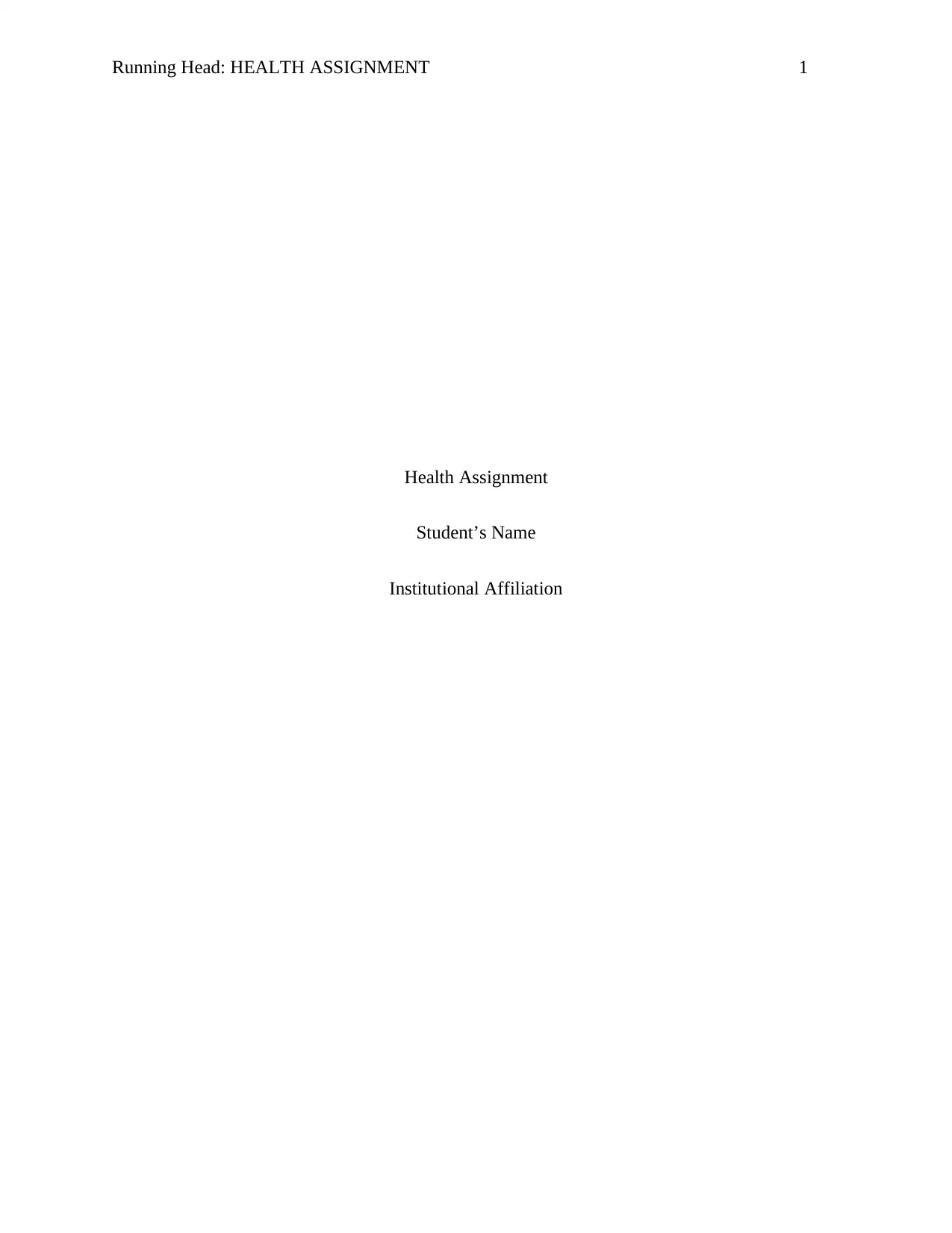
Running Head: HEALTH ASSIGNMENT 1
Health Assignment
Student’s Name
Institutional Affiliation
Health Assignment
Student’s Name
Institutional Affiliation
Secure Best Marks with AI Grader
Need help grading? Try our AI Grader for instant feedback on your assignments.
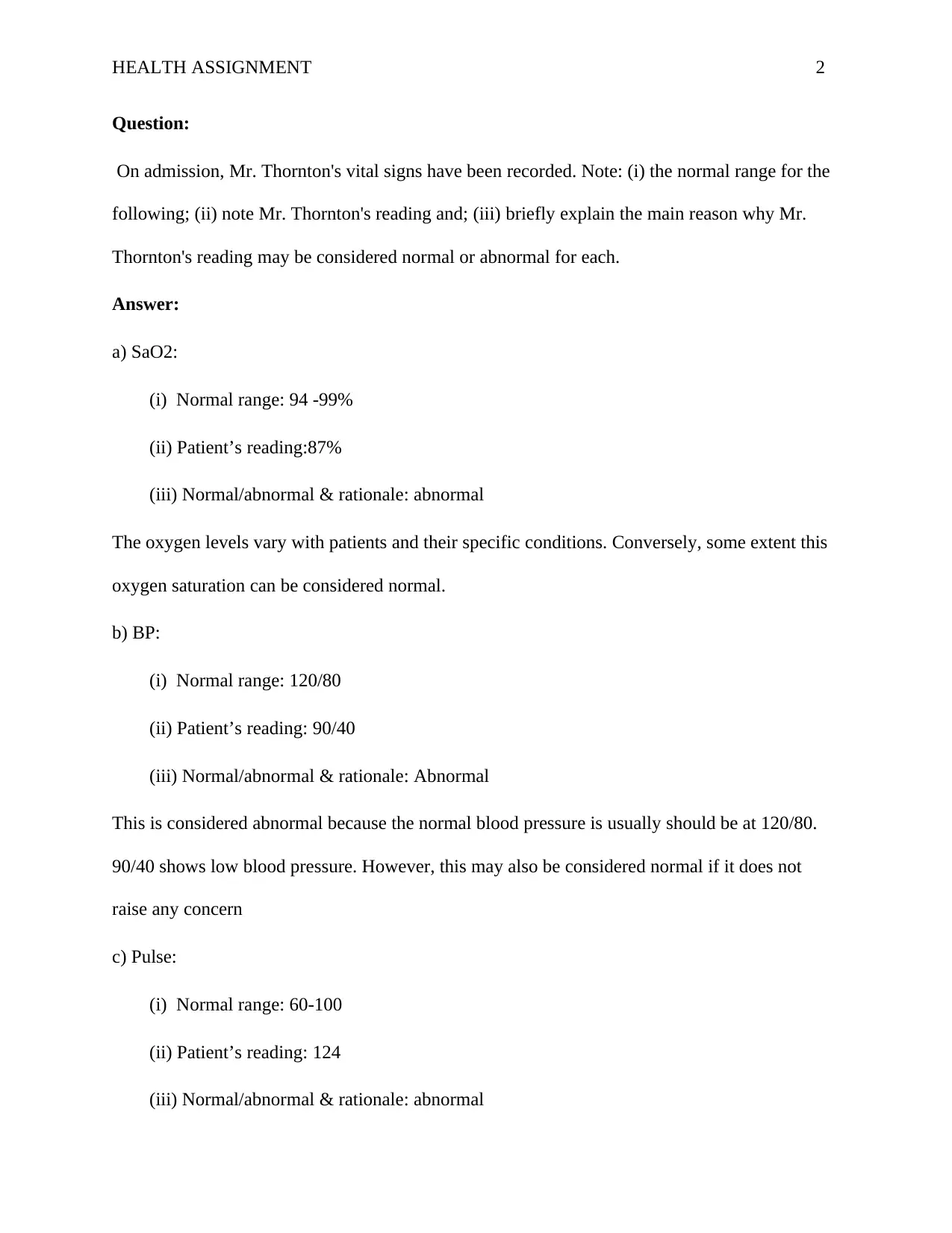
HEALTH ASSIGNMENT 2
Question:
On admission, Mr. Thornton's vital signs have been recorded. Note: (i) the normal range for the
following; (ii) note Mr. Thornton's reading and; (iii) briefly explain the main reason why Mr.
Thornton's reading may be considered normal or abnormal for each.
Answer:
a) SaO2:
(i) Normal range: 94 -99%
(ii) Patient’s reading:87%
(iii) Normal/abnormal & rationale: abnormal
The oxygen levels vary with patients and their specific conditions. Conversely, some extent this
oxygen saturation can be considered normal.
b) BP:
(i) Normal range: 120/80
(ii) Patient’s reading: 90/40
(iii) Normal/abnormal & rationale: Abnormal
This is considered abnormal because the normal blood pressure is usually should be at 120/80.
90/40 shows low blood pressure. However, this may also be considered normal if it does not
raise any concern
c) Pulse:
(i) Normal range: 60-100
(ii) Patient’s reading: 124
(iii) Normal/abnormal & rationale: abnormal
Question:
On admission, Mr. Thornton's vital signs have been recorded. Note: (i) the normal range for the
following; (ii) note Mr. Thornton's reading and; (iii) briefly explain the main reason why Mr.
Thornton's reading may be considered normal or abnormal for each.
Answer:
a) SaO2:
(i) Normal range: 94 -99%
(ii) Patient’s reading:87%
(iii) Normal/abnormal & rationale: abnormal
The oxygen levels vary with patients and their specific conditions. Conversely, some extent this
oxygen saturation can be considered normal.
b) BP:
(i) Normal range: 120/80
(ii) Patient’s reading: 90/40
(iii) Normal/abnormal & rationale: Abnormal
This is considered abnormal because the normal blood pressure is usually should be at 120/80.
90/40 shows low blood pressure. However, this may also be considered normal if it does not
raise any concern
c) Pulse:
(i) Normal range: 60-100
(ii) Patient’s reading: 124
(iii) Normal/abnormal & rationale: abnormal
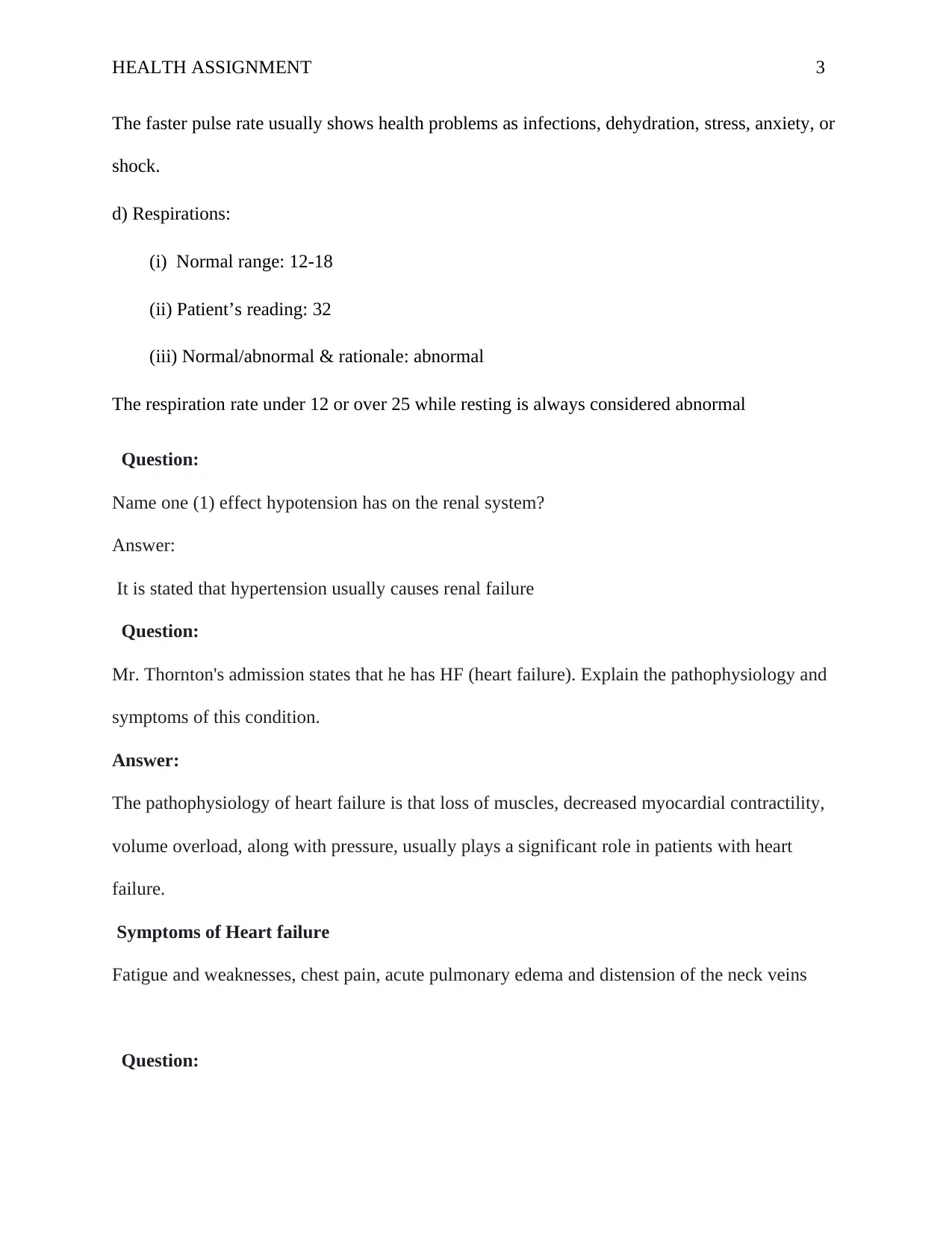
HEALTH ASSIGNMENT 3
The faster pulse rate usually shows health problems as infections, dehydration, stress, anxiety, or
shock.
d) Respirations:
(i) Normal range: 12-18
(ii) Patient’s reading: 32
(iii) Normal/abnormal & rationale: abnormal
The respiration rate under 12 or over 25 while resting is always considered abnormal
Question:
Name one (1) effect hypotension has on the renal system?
Answer:
It is stated that hypertension usually causes renal failure
Question:
Mr. Thornton's admission states that he has HF (heart failure). Explain the pathophysiology and
symptoms of this condition.
Answer:
The pathophysiology of heart failure is that loss of muscles, decreased myocardial contractility,
volume overload, along with pressure, usually plays a significant role in patients with heart
failure.
Symptoms of Heart failure
Fatigue and weaknesses, chest pain, acute pulmonary edema and distension of the neck veins
Question:
The faster pulse rate usually shows health problems as infections, dehydration, stress, anxiety, or
shock.
d) Respirations:
(i) Normal range: 12-18
(ii) Patient’s reading: 32
(iii) Normal/abnormal & rationale: abnormal
The respiration rate under 12 or over 25 while resting is always considered abnormal
Question:
Name one (1) effect hypotension has on the renal system?
Answer:
It is stated that hypertension usually causes renal failure
Question:
Mr. Thornton's admission states that he has HF (heart failure). Explain the pathophysiology and
symptoms of this condition.
Answer:
The pathophysiology of heart failure is that loss of muscles, decreased myocardial contractility,
volume overload, along with pressure, usually plays a significant role in patients with heart
failure.
Symptoms of Heart failure
Fatigue and weaknesses, chest pain, acute pulmonary edema and distension of the neck veins
Question:

HEALTH ASSIGNMENT 4
Explain what changes are likely to be occurring over time in Mr. Thornton's blood vessels as a
result of the aging process and other influences.
Answer:
The changes that will occur over time while aging is that, the capillary walls will thicken
slightly, which may lower the rate of exchange of nutrients and wastes. The main artery will
become thicker, stiffer, and less flexible. Last but not least, the baroreceptors will become less
sensitive (Bhakta, O'Brien, Karim & Esquinas, 2019).
Question:
List three (3) signs and symptoms (s/s) that are noted in Mr. Thornton's admission notes that
result from his HF.
Using your knowledge of the workings of the cardiovascular system, outline why each of these
s/s result.
Answer:
There was a rapid or irregular heartbeat
Shortness of breath
Fatigue and weaknesses
Question:
What is Diabetes Mellitus (DM)? Differentiate between Type 1 and Type 2 DM by briefly
describing the etiology of each.
Answer:
Diabetes mellitus is termed as the impaired insulin secretion in conjunction with the
variable degrees of the peripheral insulin resistance, which leads to hyperglycemia (Fuchsberger
Explain what changes are likely to be occurring over time in Mr. Thornton's blood vessels as a
result of the aging process and other influences.
Answer:
The changes that will occur over time while aging is that, the capillary walls will thicken
slightly, which may lower the rate of exchange of nutrients and wastes. The main artery will
become thicker, stiffer, and less flexible. Last but not least, the baroreceptors will become less
sensitive (Bhakta, O'Brien, Karim & Esquinas, 2019).
Question:
List three (3) signs and symptoms (s/s) that are noted in Mr. Thornton's admission notes that
result from his HF.
Using your knowledge of the workings of the cardiovascular system, outline why each of these
s/s result.
Answer:
There was a rapid or irregular heartbeat
Shortness of breath
Fatigue and weaknesses
Question:
What is Diabetes Mellitus (DM)? Differentiate between Type 1 and Type 2 DM by briefly
describing the etiology of each.
Answer:
Diabetes mellitus is termed as the impaired insulin secretion in conjunction with the
variable degrees of the peripheral insulin resistance, which leads to hyperglycemia (Fuchsberger
Secure Best Marks with AI Grader
Need help grading? Try our AI Grader for instant feedback on your assignments.
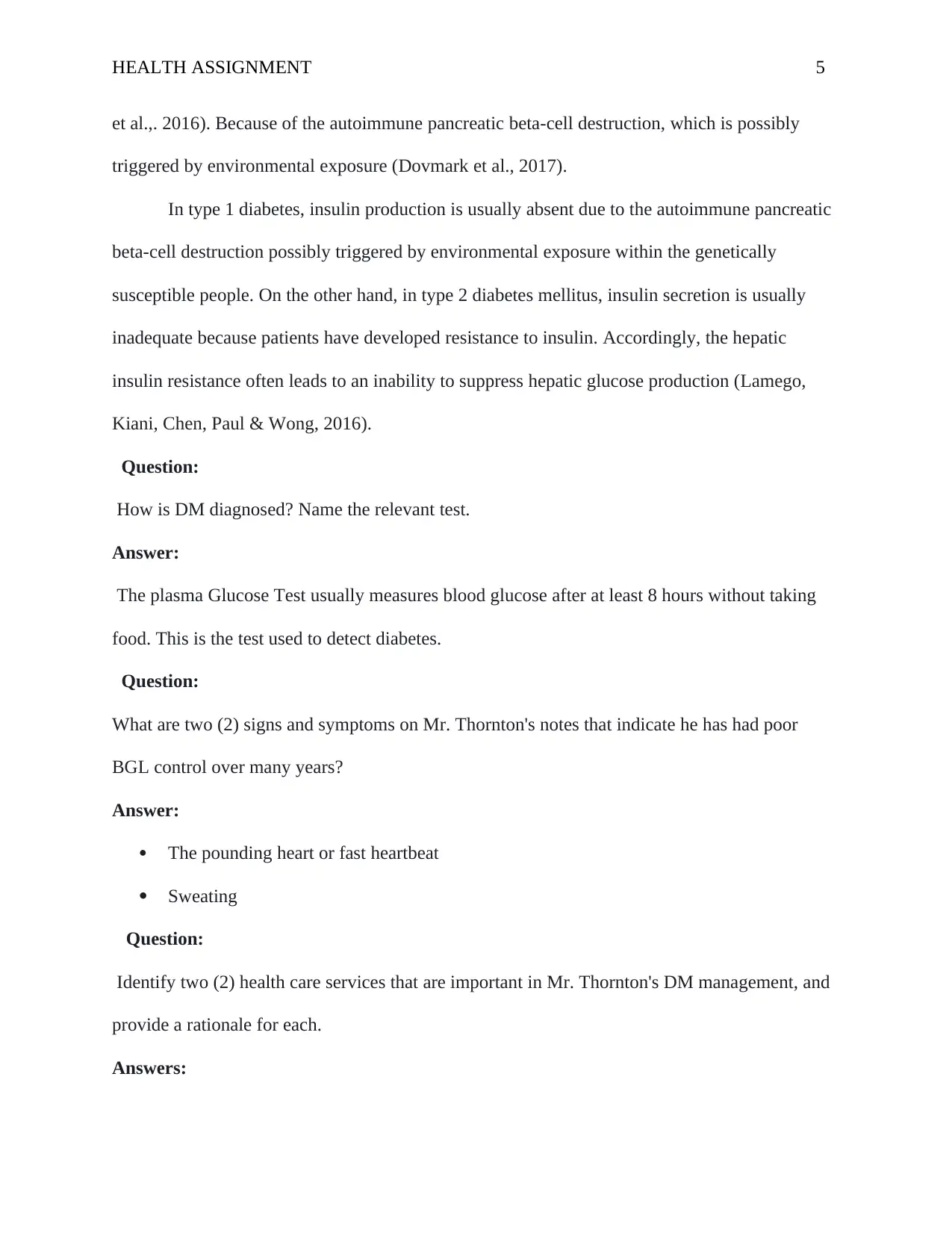
HEALTH ASSIGNMENT 5
et al.,. 2016). Because of the autoimmune pancreatic beta-cell destruction, which is possibly
triggered by environmental exposure (Dovmark et al., 2017).
In type 1 diabetes, insulin production is usually absent due to the autoimmune pancreatic
beta-cell destruction possibly triggered by environmental exposure within the genetically
susceptible people. On the other hand, in type 2 diabetes mellitus, insulin secretion is usually
inadequate because patients have developed resistance to insulin. Accordingly, the hepatic
insulin resistance often leads to an inability to suppress hepatic glucose production (Lamego,
Kiani, Chen, Paul & Wong, 2016).
Question:
How is DM diagnosed? Name the relevant test.
Answer:
The plasma Glucose Test usually measures blood glucose after at least 8 hours without taking
food. This is the test used to detect diabetes.
Question:
What are two (2) signs and symptoms on Mr. Thornton's notes that indicate he has had poor
BGL control over many years?
Answer:
The pounding heart or fast heartbeat
Sweating
Question:
Identify two (2) health care services that are important in Mr. Thornton's DM management, and
provide a rationale for each.
Answers:
et al.,. 2016). Because of the autoimmune pancreatic beta-cell destruction, which is possibly
triggered by environmental exposure (Dovmark et al., 2017).
In type 1 diabetes, insulin production is usually absent due to the autoimmune pancreatic
beta-cell destruction possibly triggered by environmental exposure within the genetically
susceptible people. On the other hand, in type 2 diabetes mellitus, insulin secretion is usually
inadequate because patients have developed resistance to insulin. Accordingly, the hepatic
insulin resistance often leads to an inability to suppress hepatic glucose production (Lamego,
Kiani, Chen, Paul & Wong, 2016).
Question:
How is DM diagnosed? Name the relevant test.
Answer:
The plasma Glucose Test usually measures blood glucose after at least 8 hours without taking
food. This is the test used to detect diabetes.
Question:
What are two (2) signs and symptoms on Mr. Thornton's notes that indicate he has had poor
BGL control over many years?
Answer:
The pounding heart or fast heartbeat
Sweating
Question:
Identify two (2) health care services that are important in Mr. Thornton's DM management, and
provide a rationale for each.
Answers:

HEALTH ASSIGNMENT 6
Planning what to eat and following the correct balanced diet.
Monitoring blood glucose and blood pressure levels at home.
Question:
List one (1) limitation that may present for the health care team when attempting to provide Mr.
Thornton's services?
Answers:
1. Gastrointestinal problems and weight gain.
Question:
His most recent hospitalization was due to a gangrenous toe. He explained to you that he had a
blister on his toe due to ill-fitting shoes which did not heal.
Explain how the amputation of Mr. Thornton's right toe is related to his diabetes.
Answers:
Diabetes can lead to peripheral artery diseases and nerve damage, together with poor
blood circulation. In that case, these problems usually make the feet vulnerable to skin sores
which worsen quickly (Hamm, Nakhoul & Hering-Smith, 2015). The nonhealing ulcer, which
causes severe damage to the tissues and bone, may need a surgical amputation.
Question:
How would Mr. Thornton's physiological stress levels from surgery effect his BGL's?
Answers:
As an illustration, when the body is under stress, the adrenal glands trigger the releases of
glucose that is stored in various body organs which leads to increased levels of glucose in the
bloodstream. This is always so problematic to people living with diabetes to regain the average
blood glucose level after stress (Nagami & Hamm, 2017).
Planning what to eat and following the correct balanced diet.
Monitoring blood glucose and blood pressure levels at home.
Question:
List one (1) limitation that may present for the health care team when attempting to provide Mr.
Thornton's services?
Answers:
1. Gastrointestinal problems and weight gain.
Question:
His most recent hospitalization was due to a gangrenous toe. He explained to you that he had a
blister on his toe due to ill-fitting shoes which did not heal.
Explain how the amputation of Mr. Thornton's right toe is related to his diabetes.
Answers:
Diabetes can lead to peripheral artery diseases and nerve damage, together with poor
blood circulation. In that case, these problems usually make the feet vulnerable to skin sores
which worsen quickly (Hamm, Nakhoul & Hering-Smith, 2015). The nonhealing ulcer, which
causes severe damage to the tissues and bone, may need a surgical amputation.
Question:
How would Mr. Thornton's physiological stress levels from surgery effect his BGL's?
Answers:
As an illustration, when the body is under stress, the adrenal glands trigger the releases of
glucose that is stored in various body organs which leads to increased levels of glucose in the
bloodstream. This is always so problematic to people living with diabetes to regain the average
blood glucose level after stress (Nagami & Hamm, 2017).
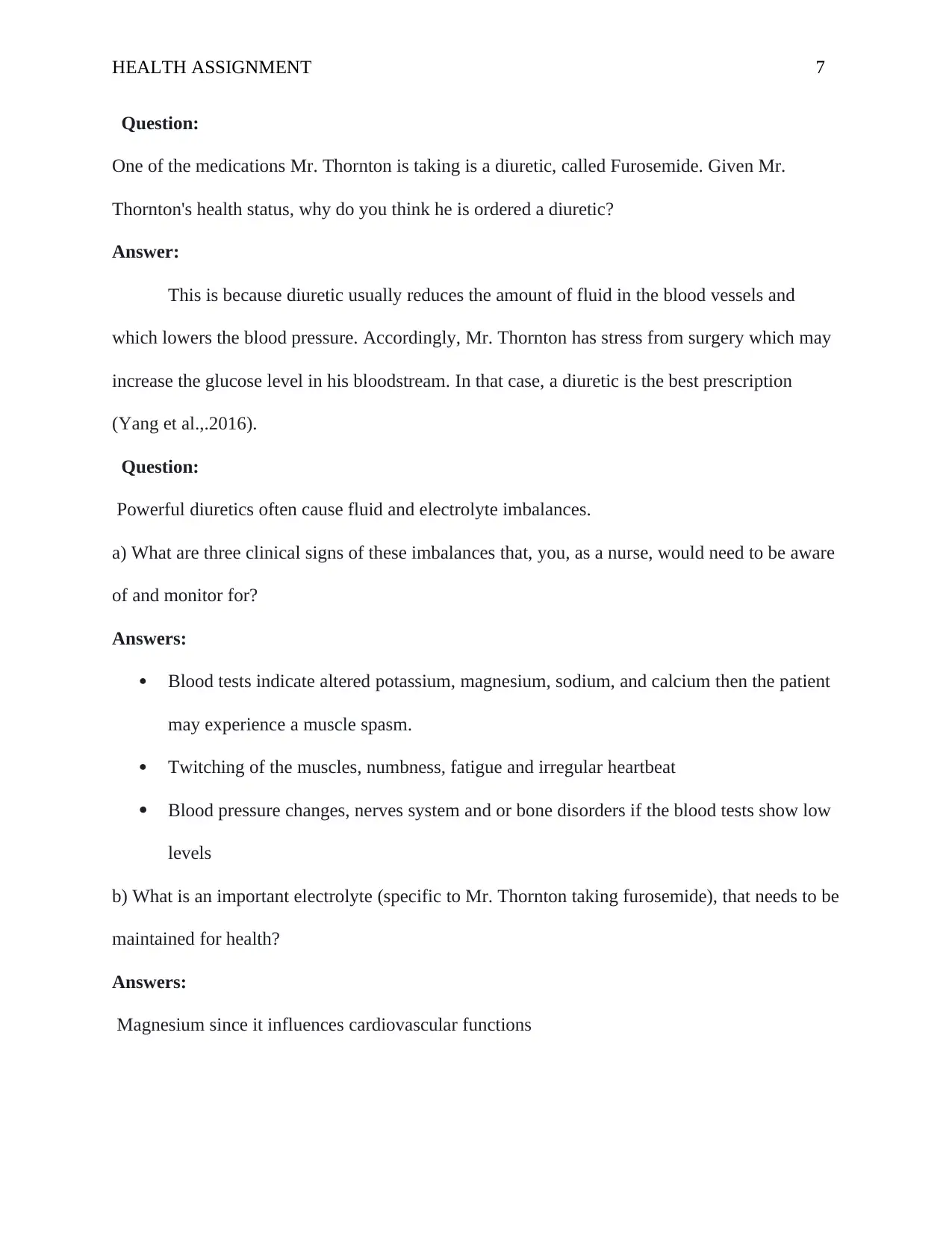
HEALTH ASSIGNMENT 7
Question:
One of the medications Mr. Thornton is taking is a diuretic, called Furosemide. Given Mr.
Thornton's health status, why do you think he is ordered a diuretic?
Answer:
This is because diuretic usually reduces the amount of fluid in the blood vessels and
which lowers the blood pressure. Accordingly, Mr. Thornton has stress from surgery which may
increase the glucose level in his bloodstream. In that case, a diuretic is the best prescription
(Yang et al.,.2016).
Question:
Powerful diuretics often cause fluid and electrolyte imbalances.
a) What are three clinical signs of these imbalances that, you, as a nurse, would need to be aware
of and monitor for?
Answers:
Blood tests indicate altered potassium, magnesium, sodium, and calcium then the patient
may experience a muscle spasm.
Twitching of the muscles, numbness, fatigue and irregular heartbeat
Blood pressure changes, nerves system and or bone disorders if the blood tests show low
levels
b) What is an important electrolyte (specific to Mr. Thornton taking furosemide), that needs to be
maintained for health?
Answers:
Magnesium since it influences cardiovascular functions
Question:
One of the medications Mr. Thornton is taking is a diuretic, called Furosemide. Given Mr.
Thornton's health status, why do you think he is ordered a diuretic?
Answer:
This is because diuretic usually reduces the amount of fluid in the blood vessels and
which lowers the blood pressure. Accordingly, Mr. Thornton has stress from surgery which may
increase the glucose level in his bloodstream. In that case, a diuretic is the best prescription
(Yang et al.,.2016).
Question:
Powerful diuretics often cause fluid and electrolyte imbalances.
a) What are three clinical signs of these imbalances that, you, as a nurse, would need to be aware
of and monitor for?
Answers:
Blood tests indicate altered potassium, magnesium, sodium, and calcium then the patient
may experience a muscle spasm.
Twitching of the muscles, numbness, fatigue and irregular heartbeat
Blood pressure changes, nerves system and or bone disorders if the blood tests show low
levels
b) What is an important electrolyte (specific to Mr. Thornton taking furosemide), that needs to be
maintained for health?
Answers:
Magnesium since it influences cardiovascular functions
Paraphrase This Document
Need a fresh take? Get an instant paraphrase of this document with our AI Paraphraser

HEALTH ASSIGNMENT 8
c) What is a type of supplementation (related to part b), either dietary or drug, that is often
prescribed concurrently with diuretic medications?
Answers:
Felodipine and amlodipine
Question:
How do the lungs assist with the regulation of the acid-base balance?
Answer:
When carbon dioxide accumulates in the blood, the acidity increases. However, by adjusting the
speed and depth of breathing, the blood PH can be regulated slowly by slowly.
Question:
How do the kidneys maintain acid-base balance?
Answer:
The kidney usually maintains acid-base balance by excreting ions into urine and reabsorbing
bicarbonate from urine.
Question:
Assess Mr. Thornton's relevant medical history for conditions that are commonly associated
with the aging process. Note four (4) of these conditions, (other than diabetes or those of the
cardiovascular or respiratory system that have already been discussed)
Answer:
1. Hearing loss
2. Fragile bones
3. Cancer
4. Weight gain
c) What is a type of supplementation (related to part b), either dietary or drug, that is often
prescribed concurrently with diuretic medications?
Answers:
Felodipine and amlodipine
Question:
How do the lungs assist with the regulation of the acid-base balance?
Answer:
When carbon dioxide accumulates in the blood, the acidity increases. However, by adjusting the
speed and depth of breathing, the blood PH can be regulated slowly by slowly.
Question:
How do the kidneys maintain acid-base balance?
Answer:
The kidney usually maintains acid-base balance by excreting ions into urine and reabsorbing
bicarbonate from urine.
Question:
Assess Mr. Thornton's relevant medical history for conditions that are commonly associated
with the aging process. Note four (4) of these conditions, (other than diabetes or those of the
cardiovascular or respiratory system that have already been discussed)
Answer:
1. Hearing loss
2. Fragile bones
3. Cancer
4. Weight gain

HEALTH ASSIGNMENT 9
Case Study 2
Brian Lane is a 69-year-old man who has a diagnosis of COPD. He is retired and a heavy
smoker.
Question:
What does the acronym COPD stand for?
Answer:
Chronic obstructive pulmonary disease
Question:
There are two main categories of COPD: emphysema and chronic bronchitis. Identify a
significant difference in pathophysiology of lung tissue between these disease processes.
Answer:
The significant difference between these two conditions is that chronic bronchitis usually
produces a lot of cough with mucus.
Question:
Often 5mg salbutamol (Ventolin), is prescribed for asthma. It is known as a b2 receptor agonist
or a sympathomimetic drug.
a) What does this mean, in terms of how it works within the Autonomic Nervous System?
Answer:
It means it usually affects the smooth muscle cause dilation of the bronchial passages, liver, and
vasodilation in muscle.
b) List two (2) other adverse effects that may occur in the body if the recommended dose of the
drug is exceeded?
Answer:
Case Study 2
Brian Lane is a 69-year-old man who has a diagnosis of COPD. He is retired and a heavy
smoker.
Question:
What does the acronym COPD stand for?
Answer:
Chronic obstructive pulmonary disease
Question:
There are two main categories of COPD: emphysema and chronic bronchitis. Identify a
significant difference in pathophysiology of lung tissue between these disease processes.
Answer:
The significant difference between these two conditions is that chronic bronchitis usually
produces a lot of cough with mucus.
Question:
Often 5mg salbutamol (Ventolin), is prescribed for asthma. It is known as a b2 receptor agonist
or a sympathomimetic drug.
a) What does this mean, in terms of how it works within the Autonomic Nervous System?
Answer:
It means it usually affects the smooth muscle cause dilation of the bronchial passages, liver, and
vasodilation in muscle.
b) List two (2) other adverse effects that may occur in the body if the recommended dose of the
drug is exceeded?
Answer:

HEALTH ASSIGNMENT 10
It usually results in cardiac effects such as hypertension
Vasoconstriction and stroke-like syndromes
Case Study 3
Mary, who is 74 years old, has been put in a bath with water that was too hot and has
received burns to 25% of her lower body of varying depths.
Question:
Why is dehydration and electrolyte imbalance a danger in Mary’s case?
Answer:
The electrolyte imbalance is usually caused loss of bodily fluids via sweating or burns. In that
case, there are high chances for Mary to experience these conditions because 25% burns mean a
lot of fluid was lost.
Question:
Name the three (3) phases of healing that will occur to the areas of the skin that have been burnt?
Answer:
1. Hemostasis phase
2. Defensive/inflammatory phase
3. Proliferative phase
Question:
Mary undergoes debridement of the burns. What does this mean?
Answer:
This means the removal of the burned tissue of the burns which can include autolytic, surgical,
mechanical or chemical tissue removal
Case Study 4
It usually results in cardiac effects such as hypertension
Vasoconstriction and stroke-like syndromes
Case Study 3
Mary, who is 74 years old, has been put in a bath with water that was too hot and has
received burns to 25% of her lower body of varying depths.
Question:
Why is dehydration and electrolyte imbalance a danger in Mary’s case?
Answer:
The electrolyte imbalance is usually caused loss of bodily fluids via sweating or burns. In that
case, there are high chances for Mary to experience these conditions because 25% burns mean a
lot of fluid was lost.
Question:
Name the three (3) phases of healing that will occur to the areas of the skin that have been burnt?
Answer:
1. Hemostasis phase
2. Defensive/inflammatory phase
3. Proliferative phase
Question:
Mary undergoes debridement of the burns. What does this mean?
Answer:
This means the removal of the burned tissue of the burns which can include autolytic, surgical,
mechanical or chemical tissue removal
Case Study 4
Secure Best Marks with AI Grader
Need help grading? Try our AI Grader for instant feedback on your assignments.
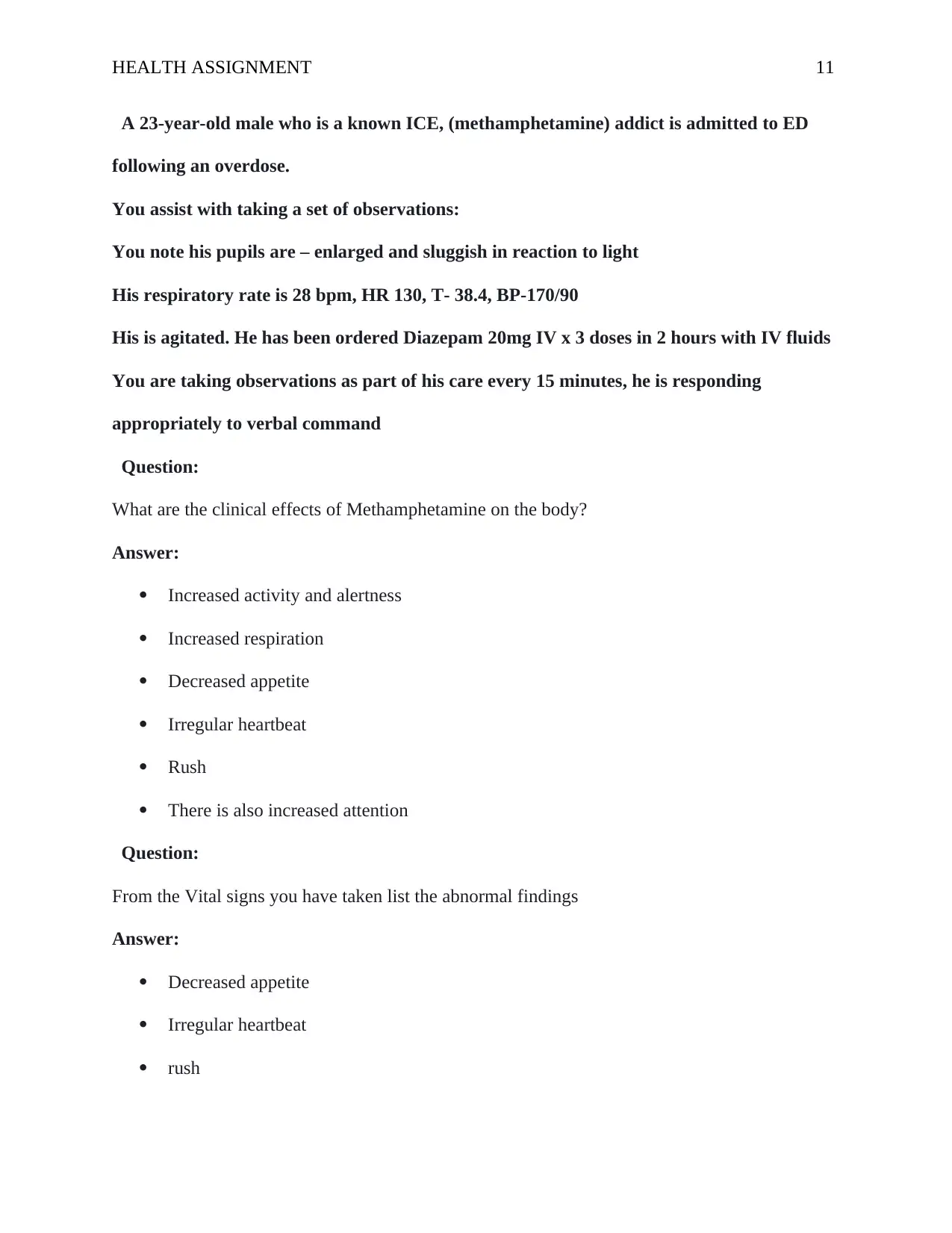
HEALTH ASSIGNMENT 11
A 23-year-old male who is a known ICE, (methamphetamine) addict is admitted to ED
following an overdose.
You assist with taking a set of observations:
You note his pupils are – enlarged and sluggish in reaction to light
His respiratory rate is 28 bpm, HR 130, T- 38.4, BP-170/90
His is agitated. He has been ordered Diazepam 20mg IV x 3 doses in 2 hours with IV fluids
You are taking observations as part of his care every 15 minutes, he is responding
appropriately to verbal command
Question:
What are the clinical effects of Methamphetamine on the body?
Answer:
Increased activity and alertness
Increased respiration
Decreased appetite
Irregular heartbeat
Rush
There is also increased attention
Question:
From the Vital signs you have taken list the abnormal findings
Answer:
Decreased appetite
Irregular heartbeat
rush
A 23-year-old male who is a known ICE, (methamphetamine) addict is admitted to ED
following an overdose.
You assist with taking a set of observations:
You note his pupils are – enlarged and sluggish in reaction to light
His respiratory rate is 28 bpm, HR 130, T- 38.4, BP-170/90
His is agitated. He has been ordered Diazepam 20mg IV x 3 doses in 2 hours with IV fluids
You are taking observations as part of his care every 15 minutes, he is responding
appropriately to verbal command
Question:
What are the clinical effects of Methamphetamine on the body?
Answer:
Increased activity and alertness
Increased respiration
Decreased appetite
Irregular heartbeat
Rush
There is also increased attention
Question:
From the Vital signs you have taken list the abnormal findings
Answer:
Decreased appetite
Irregular heartbeat
rush

HEALTH ASSIGNMENT 12
Question:
Provide a rationale for conducting 15-minute vital signs
Answer:
To check if there is any abnormal sign coming up
Case Study 5
Michael Molloy is a 23-year-old who has presented to Accident and Emergency via an
ambulance. Michael was playing AFL with his local club and has been hit in the head with
an opponent's player's knee. It was handed over that Michael experienced "a brief period
of unresponsiveness and has an indentation in his skull just above his left eye."
Michaels presentation in Accident and Emergency:
· Responsive and cooperative, orientated to time, person and place
· Headache, pain rating 8/10
· Nauseous but has not vomited
· Resp 24bpm, Temp 36.8c, BP 144/78, pulse 74bpm, O2 sats 98%
Post-X-ray Michael has been given the diagnosis of depressed fracture of the skull with loss
of consciousness, (concussion).
Michael is now stable and is to be transported to the ward and then onto theatre for a
repair of the depressed skull fracture.
Question:
Describe what happens to the brain following a blow to the head that then results in a
concussion
Answer:
Question:
Provide a rationale for conducting 15-minute vital signs
Answer:
To check if there is any abnormal sign coming up
Case Study 5
Michael Molloy is a 23-year-old who has presented to Accident and Emergency via an
ambulance. Michael was playing AFL with his local club and has been hit in the head with
an opponent's player's knee. It was handed over that Michael experienced "a brief period
of unresponsiveness and has an indentation in his skull just above his left eye."
Michaels presentation in Accident and Emergency:
· Responsive and cooperative, orientated to time, person and place
· Headache, pain rating 8/10
· Nauseous but has not vomited
· Resp 24bpm, Temp 36.8c, BP 144/78, pulse 74bpm, O2 sats 98%
Post-X-ray Michael has been given the diagnosis of depressed fracture of the skull with loss
of consciousness, (concussion).
Michael is now stable and is to be transported to the ward and then onto theatre for a
repair of the depressed skull fracture.
Question:
Describe what happens to the brain following a blow to the head that then results in a
concussion
Answer:
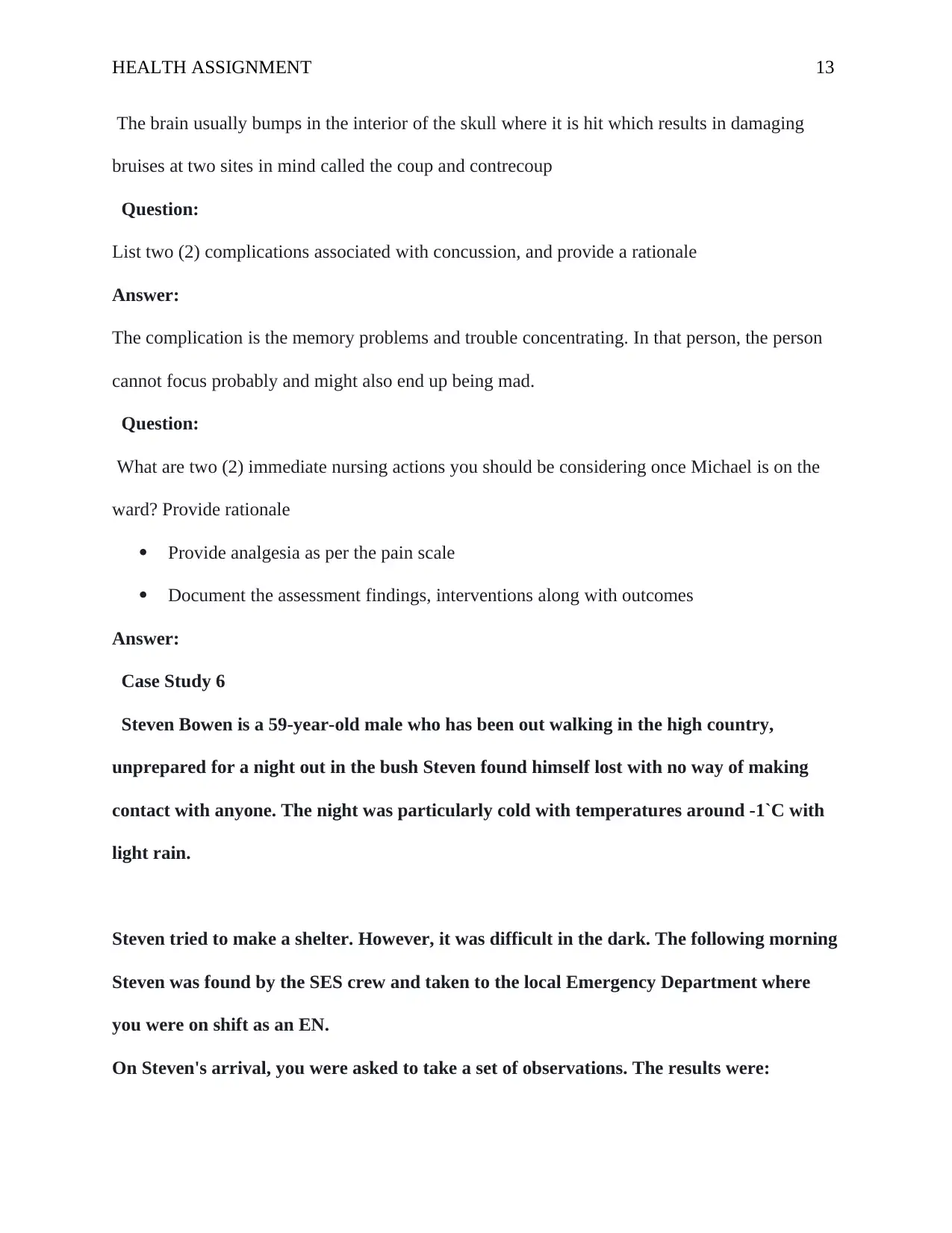
HEALTH ASSIGNMENT 13
The brain usually bumps in the interior of the skull where it is hit which results in damaging
bruises at two sites in mind called the coup and contrecoup
Question:
List two (2) complications associated with concussion, and provide a rationale
Answer:
The complication is the memory problems and trouble concentrating. In that person, the person
cannot focus probably and might also end up being mad.
Question:
What are two (2) immediate nursing actions you should be considering once Michael is on the
ward? Provide rationale
Provide analgesia as per the pain scale
Document the assessment findings, interventions along with outcomes
Answer:
Case Study 6
Steven Bowen is a 59-year-old male who has been out walking in the high country,
unprepared for a night out in the bush Steven found himself lost with no way of making
contact with anyone. The night was particularly cold with temperatures around -1`C with
light rain.
Steven tried to make a shelter. However, it was difficult in the dark. The following morning
Steven was found by the SES crew and taken to the local Emergency Department where
you were on shift as an EN.
On Steven's arrival, you were asked to take a set of observations. The results were:
The brain usually bumps in the interior of the skull where it is hit which results in damaging
bruises at two sites in mind called the coup and contrecoup
Question:
List two (2) complications associated with concussion, and provide a rationale
Answer:
The complication is the memory problems and trouble concentrating. In that person, the person
cannot focus probably and might also end up being mad.
Question:
What are two (2) immediate nursing actions you should be considering once Michael is on the
ward? Provide rationale
Provide analgesia as per the pain scale
Document the assessment findings, interventions along with outcomes
Answer:
Case Study 6
Steven Bowen is a 59-year-old male who has been out walking in the high country,
unprepared for a night out in the bush Steven found himself lost with no way of making
contact with anyone. The night was particularly cold with temperatures around -1`C with
light rain.
Steven tried to make a shelter. However, it was difficult in the dark. The following morning
Steven was found by the SES crew and taken to the local Emergency Department where
you were on shift as an EN.
On Steven's arrival, you were asked to take a set of observations. The results were:
Paraphrase This Document
Need a fresh take? Get an instant paraphrase of this document with our AI Paraphraser
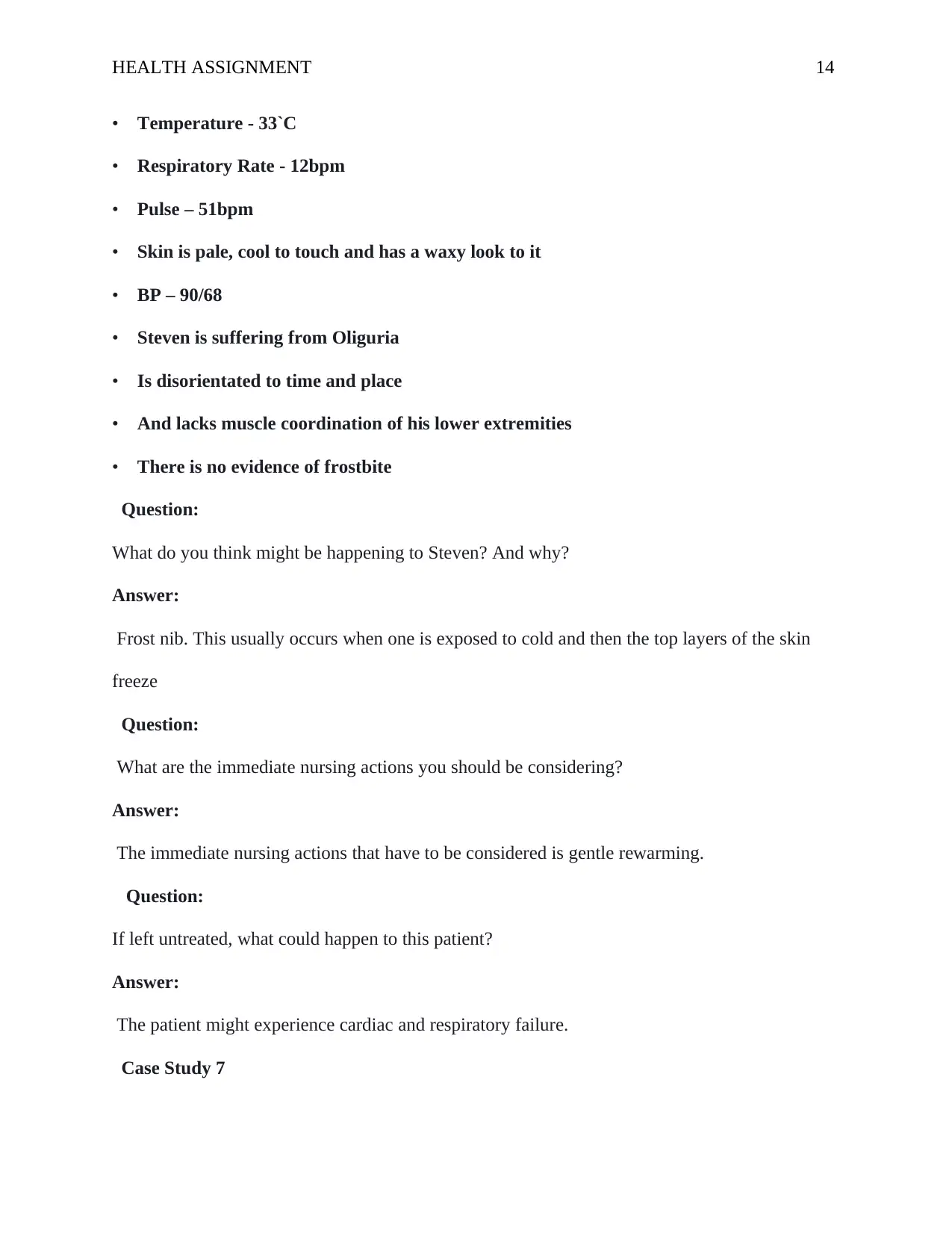
HEALTH ASSIGNMENT 14
• Temperature - 33`C
• Respiratory Rate - 12bpm
• Pulse – 51bpm
• Skin is pale, cool to touch and has a waxy look to it
• BP – 90/68
• Steven is suffering from Oliguria
• Is disorientated to time and place
• And lacks muscle coordination of his lower extremities
• There is no evidence of frostbite
Question:
What do you think might be happening to Steven? And why?
Answer:
Frost nib. This usually occurs when one is exposed to cold and then the top layers of the skin
freeze
Question:
What are the immediate nursing actions you should be considering?
Answer:
The immediate nursing actions that have to be considered is gentle rewarming.
Question:
If left untreated, what could happen to this patient?
Answer:
The patient might experience cardiac and respiratory failure.
Case Study 7
• Temperature - 33`C
• Respiratory Rate - 12bpm
• Pulse – 51bpm
• Skin is pale, cool to touch and has a waxy look to it
• BP – 90/68
• Steven is suffering from Oliguria
• Is disorientated to time and place
• And lacks muscle coordination of his lower extremities
• There is no evidence of frostbite
Question:
What do you think might be happening to Steven? And why?
Answer:
Frost nib. This usually occurs when one is exposed to cold and then the top layers of the skin
freeze
Question:
What are the immediate nursing actions you should be considering?
Answer:
The immediate nursing actions that have to be considered is gentle rewarming.
Question:
If left untreated, what could happen to this patient?
Answer:
The patient might experience cardiac and respiratory failure.
Case Study 7
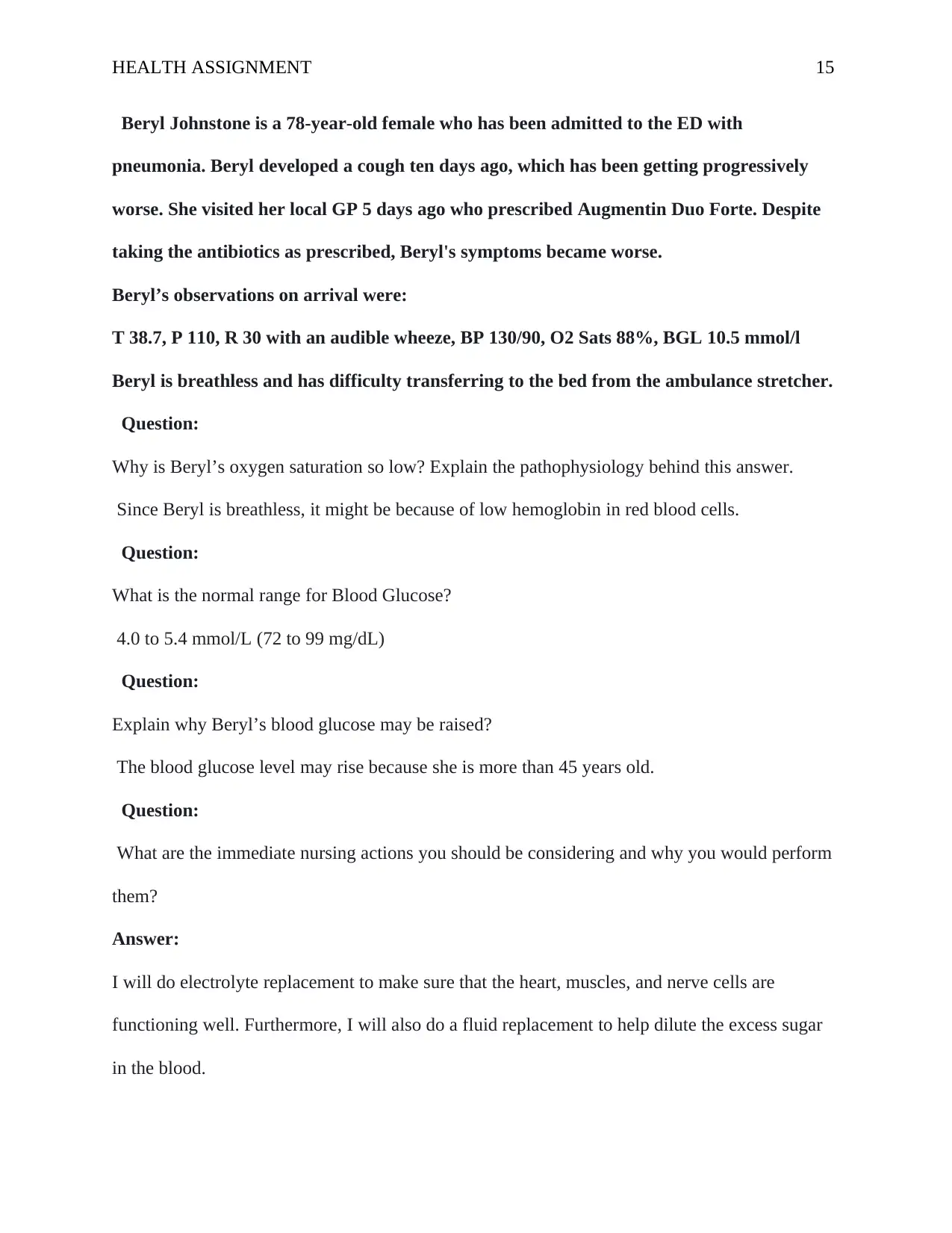
HEALTH ASSIGNMENT 15
Beryl Johnstone is a 78-year-old female who has been admitted to the ED with
pneumonia. Beryl developed a cough ten days ago, which has been getting progressively
worse. She visited her local GP 5 days ago who prescribed Augmentin Duo Forte. Despite
taking the antibiotics as prescribed, Beryl's symptoms became worse.
Beryl’s observations on arrival were:
T 38.7, P 110, R 30 with an audible wheeze, BP 130/90, O2 Sats 88%, BGL 10.5 mmol/l
Beryl is breathless and has difficulty transferring to the bed from the ambulance stretcher.
Question:
Why is Beryl’s oxygen saturation so low? Explain the pathophysiology behind this answer.
Since Beryl is breathless, it might be because of low hemoglobin in red blood cells.
Question:
What is the normal range for Blood Glucose?
4.0 to 5.4 mmol/L (72 to 99 mg/dL)
Question:
Explain why Beryl’s blood glucose may be raised?
The blood glucose level may rise because she is more than 45 years old.
Question:
What are the immediate nursing actions you should be considering and why you would perform
them?
Answer:
I will do electrolyte replacement to make sure that the heart, muscles, and nerve cells are
functioning well. Furthermore, I will also do a fluid replacement to help dilute the excess sugar
in the blood.
Beryl Johnstone is a 78-year-old female who has been admitted to the ED with
pneumonia. Beryl developed a cough ten days ago, which has been getting progressively
worse. She visited her local GP 5 days ago who prescribed Augmentin Duo Forte. Despite
taking the antibiotics as prescribed, Beryl's symptoms became worse.
Beryl’s observations on arrival were:
T 38.7, P 110, R 30 with an audible wheeze, BP 130/90, O2 Sats 88%, BGL 10.5 mmol/l
Beryl is breathless and has difficulty transferring to the bed from the ambulance stretcher.
Question:
Why is Beryl’s oxygen saturation so low? Explain the pathophysiology behind this answer.
Since Beryl is breathless, it might be because of low hemoglobin in red blood cells.
Question:
What is the normal range for Blood Glucose?
4.0 to 5.4 mmol/L (72 to 99 mg/dL)
Question:
Explain why Beryl’s blood glucose may be raised?
The blood glucose level may rise because she is more than 45 years old.
Question:
What are the immediate nursing actions you should be considering and why you would perform
them?
Answer:
I will do electrolyte replacement to make sure that the heart, muscles, and nerve cells are
functioning well. Furthermore, I will also do a fluid replacement to help dilute the excess sugar
in the blood.
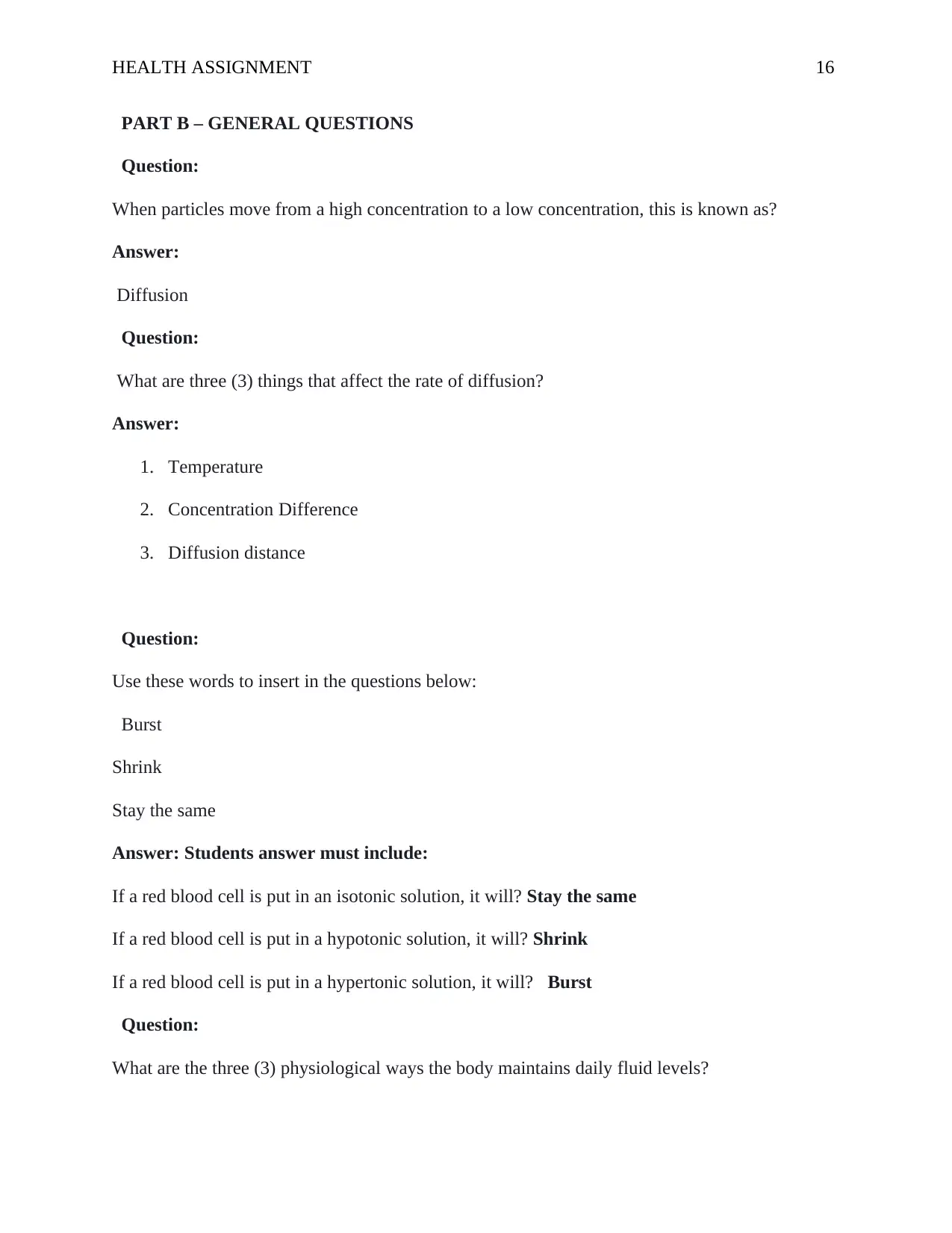
HEALTH ASSIGNMENT 16
PART B – GENERAL QUESTIONS
Question:
When particles move from a high concentration to a low concentration, this is known as?
Answer:
Diffusion
Question:
What are three (3) things that affect the rate of diffusion?
Answer:
1. Temperature
2. Concentration Difference
3. Diffusion distance
Question:
Use these words to insert in the questions below:
Burst
Shrink
Stay the same
Answer: Students answer must include:
If a red blood cell is put in an isotonic solution, it will? Stay the same
If a red blood cell is put in a hypotonic solution, it will? Shrink
If a red blood cell is put in a hypertonic solution, it will? Burst
Question:
What are the three (3) physiological ways the body maintains daily fluid levels?
PART B – GENERAL QUESTIONS
Question:
When particles move from a high concentration to a low concentration, this is known as?
Answer:
Diffusion
Question:
What are three (3) things that affect the rate of diffusion?
Answer:
1. Temperature
2. Concentration Difference
3. Diffusion distance
Question:
Use these words to insert in the questions below:
Burst
Shrink
Stay the same
Answer: Students answer must include:
If a red blood cell is put in an isotonic solution, it will? Stay the same
If a red blood cell is put in a hypotonic solution, it will? Shrink
If a red blood cell is put in a hypertonic solution, it will? Burst
Question:
What are the three (3) physiological ways the body maintains daily fluid levels?
Secure Best Marks with AI Grader
Need help grading? Try our AI Grader for instant feedback on your assignments.
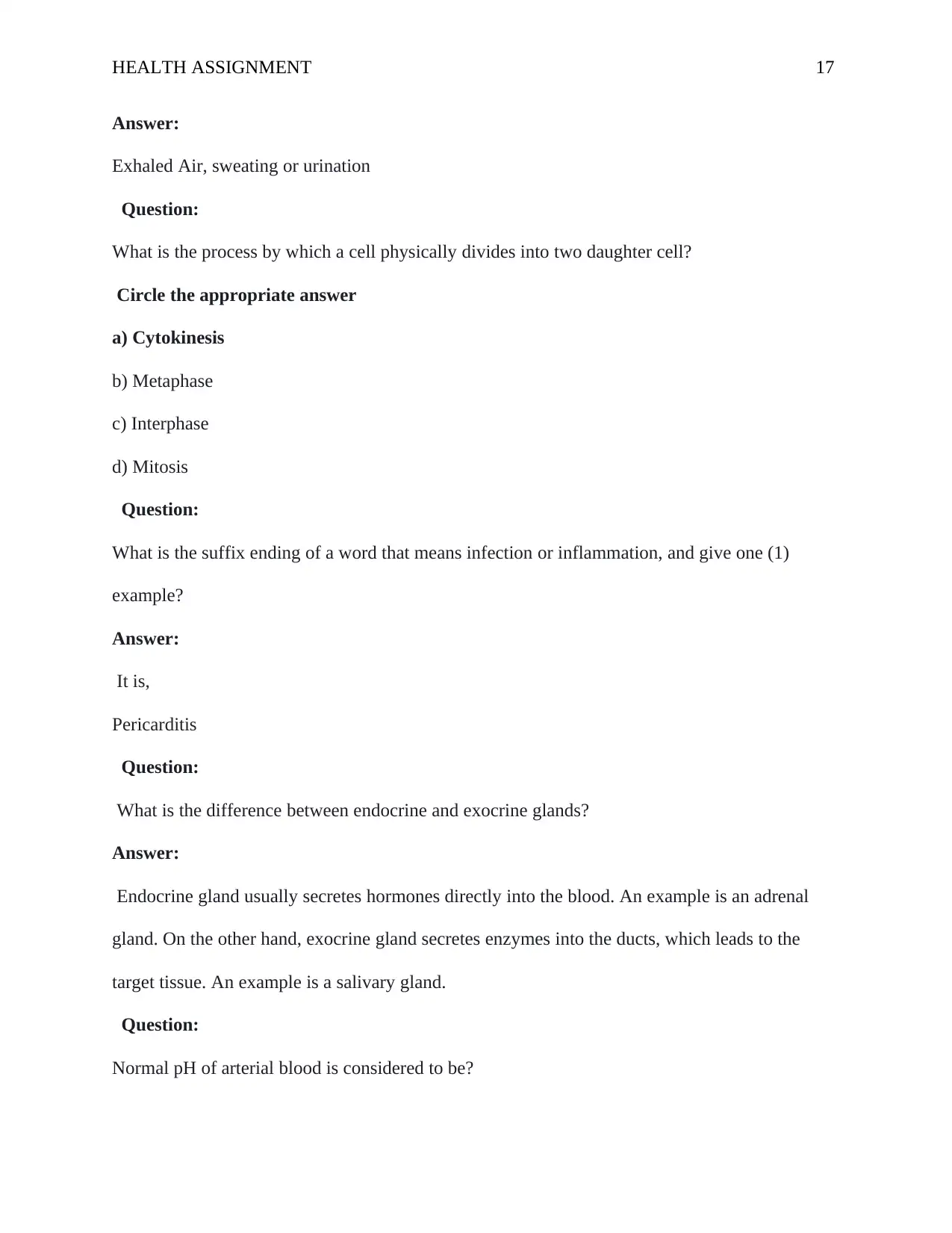
HEALTH ASSIGNMENT 17
Answer:
Exhaled Air, sweating or urination
Question:
What is the process by which a cell physically divides into two daughter cell?
Circle the appropriate answer
a) Cytokinesis
b) Metaphase
c) Interphase
d) Mitosis
Question:
What is the suffix ending of a word that means infection or inflammation, and give one (1)
example?
Answer:
It is,
Pericarditis
Question:
What is the difference between endocrine and exocrine glands?
Answer:
Endocrine gland usually secretes hormones directly into the blood. An example is an adrenal
gland. On the other hand, exocrine gland secretes enzymes into the ducts, which leads to the
target tissue. An example is a salivary gland.
Question:
Normal pH of arterial blood is considered to be?
Answer:
Exhaled Air, sweating or urination
Question:
What is the process by which a cell physically divides into two daughter cell?
Circle the appropriate answer
a) Cytokinesis
b) Metaphase
c) Interphase
d) Mitosis
Question:
What is the suffix ending of a word that means infection or inflammation, and give one (1)
example?
Answer:
It is,
Pericarditis
Question:
What is the difference between endocrine and exocrine glands?
Answer:
Endocrine gland usually secretes hormones directly into the blood. An example is an adrenal
gland. On the other hand, exocrine gland secretes enzymes into the ducts, which leads to the
target tissue. An example is a salivary gland.
Question:
Normal pH of arterial blood is considered to be?
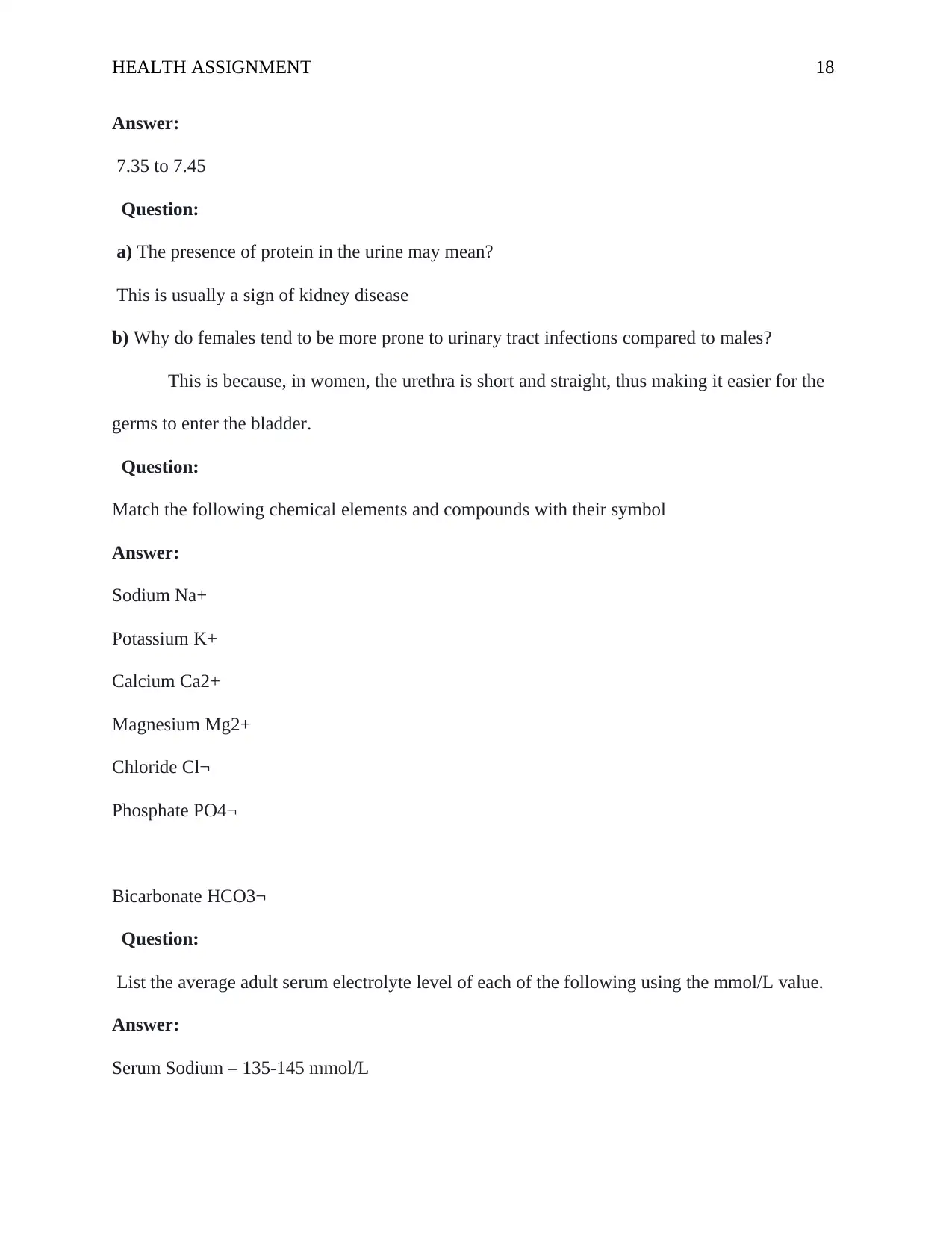
HEALTH ASSIGNMENT 18
Answer:
7.35 to 7.45
Question:
a) The presence of protein in the urine may mean?
This is usually a sign of kidney disease
b) Why do females tend to be more prone to urinary tract infections compared to males?
This is because, in women, the urethra is short and straight, thus making it easier for the
germs to enter the bladder.
Question:
Match the following chemical elements and compounds with their symbol
Answer:
Sodium Na+
Potassium K+
Calcium Ca2+
Magnesium Mg2+
Chloride Cl¬
Phosphate PO4¬
Bicarbonate HCO3¬
Question:
List the average adult serum electrolyte level of each of the following using the mmol/L value.
Answer:
Serum Sodium – 135-145 mmol/L
Answer:
7.35 to 7.45
Question:
a) The presence of protein in the urine may mean?
This is usually a sign of kidney disease
b) Why do females tend to be more prone to urinary tract infections compared to males?
This is because, in women, the urethra is short and straight, thus making it easier for the
germs to enter the bladder.
Question:
Match the following chemical elements and compounds with their symbol
Answer:
Sodium Na+
Potassium K+
Calcium Ca2+
Magnesium Mg2+
Chloride Cl¬
Phosphate PO4¬
Bicarbonate HCO3¬
Question:
List the average adult serum electrolyte level of each of the following using the mmol/L value.
Answer:
Serum Sodium – 135-145 mmol/L
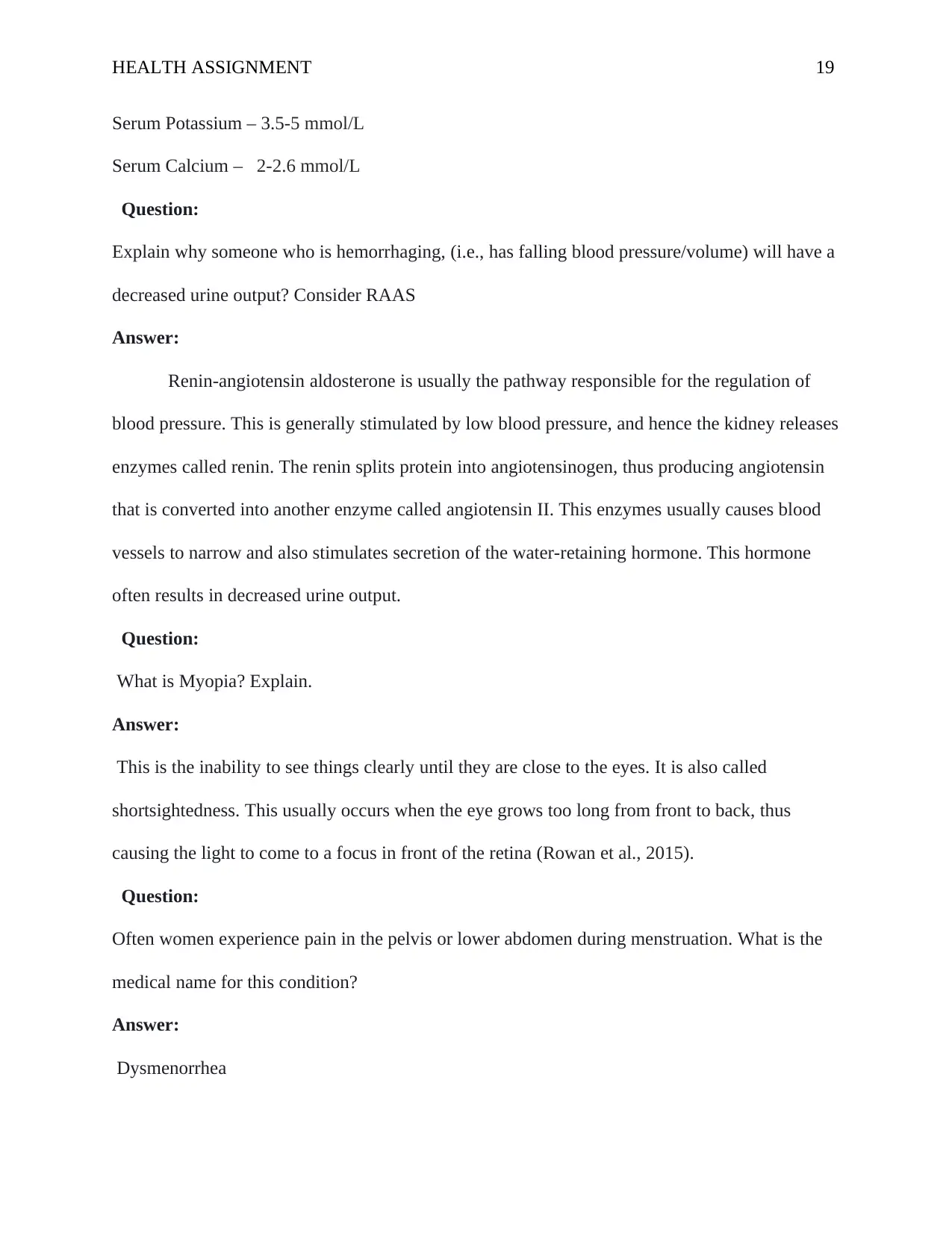
HEALTH ASSIGNMENT 19
Serum Potassium – 3.5-5 mmol/L
Serum Calcium – 2-2.6 mmol/L
Question:
Explain why someone who is hemorrhaging, (i.e., has falling blood pressure/volume) will have a
decreased urine output? Consider RAAS
Answer:
Renin-angiotensin aldosterone is usually the pathway responsible for the regulation of
blood pressure. This is generally stimulated by low blood pressure, and hence the kidney releases
enzymes called renin. The renin splits protein into angiotensinogen, thus producing angiotensin
that is converted into another enzyme called angiotensin II. This enzymes usually causes blood
vessels to narrow and also stimulates secretion of the water-retaining hormone. This hormone
often results in decreased urine output.
Question:
What is Myopia? Explain.
Answer:
This is the inability to see things clearly until they are close to the eyes. It is also called
shortsightedness. This usually occurs when the eye grows too long from front to back, thus
causing the light to come to a focus in front of the retina (Rowan et al., 2015).
Question:
Often women experience pain in the pelvis or lower abdomen during menstruation. What is the
medical name for this condition?
Answer:
Dysmenorrhea
Serum Potassium – 3.5-5 mmol/L
Serum Calcium – 2-2.6 mmol/L
Question:
Explain why someone who is hemorrhaging, (i.e., has falling blood pressure/volume) will have a
decreased urine output? Consider RAAS
Answer:
Renin-angiotensin aldosterone is usually the pathway responsible for the regulation of
blood pressure. This is generally stimulated by low blood pressure, and hence the kidney releases
enzymes called renin. The renin splits protein into angiotensinogen, thus producing angiotensin
that is converted into another enzyme called angiotensin II. This enzymes usually causes blood
vessels to narrow and also stimulates secretion of the water-retaining hormone. This hormone
often results in decreased urine output.
Question:
What is Myopia? Explain.
Answer:
This is the inability to see things clearly until they are close to the eyes. It is also called
shortsightedness. This usually occurs when the eye grows too long from front to back, thus
causing the light to come to a focus in front of the retina (Rowan et al., 2015).
Question:
Often women experience pain in the pelvis or lower abdomen during menstruation. What is the
medical name for this condition?
Answer:
Dysmenorrhea
Paraphrase This Document
Need a fresh take? Get an instant paraphrase of this document with our AI Paraphraser

HEALTH ASSIGNMENT 20
Question:
Define the terms below, give ranges, and give associated risks or complications
Answer:
Pyrexia:
It is the medical term for fever. It is when the body temperature rises above the average of 37
degrees. The associated risk complication is that enzymes protein is damaged and hence, in turn,
the rate of reaction reduces.
Hyperpyrexia:
This usually occurs when the body temperatures rise above 106.7 degrees. It is generally
considered as the medical emergency and hence requires immediate treatment. There is also a
loss of consciousness, confusion, and rapid breathing (Sood et al., 2016).
Question:
What is presbycussis? Describe the degenerative change that occurs and explain the symptoms it
produces.
Answer:
Is the loss of hearing that gradually occurs in people as they grow older. There is usually
degeneration of the hair cells at the base of the cochlea along with nerve cells in spiral ganglia.
Some of the symptoms are as highlighted below (De Kloet et al.,.2016). The first one is that the
speech of others sounds mumbled or slurred. Accordingly, some sounds seem overly loud and
annoying.
References
Question:
Define the terms below, give ranges, and give associated risks or complications
Answer:
Pyrexia:
It is the medical term for fever. It is when the body temperature rises above the average of 37
degrees. The associated risk complication is that enzymes protein is damaged and hence, in turn,
the rate of reaction reduces.
Hyperpyrexia:
This usually occurs when the body temperatures rise above 106.7 degrees. It is generally
considered as the medical emergency and hence requires immediate treatment. There is also a
loss of consciousness, confusion, and rapid breathing (Sood et al., 2016).
Question:
What is presbycussis? Describe the degenerative change that occurs and explain the symptoms it
produces.
Answer:
Is the loss of hearing that gradually occurs in people as they grow older. There is usually
degeneration of the hair cells at the base of the cochlea along with nerve cells in spiral ganglia.
Some of the symptoms are as highlighted below (De Kloet et al.,.2016). The first one is that the
speech of others sounds mumbled or slurred. Accordingly, some sounds seem overly loud and
annoying.
References
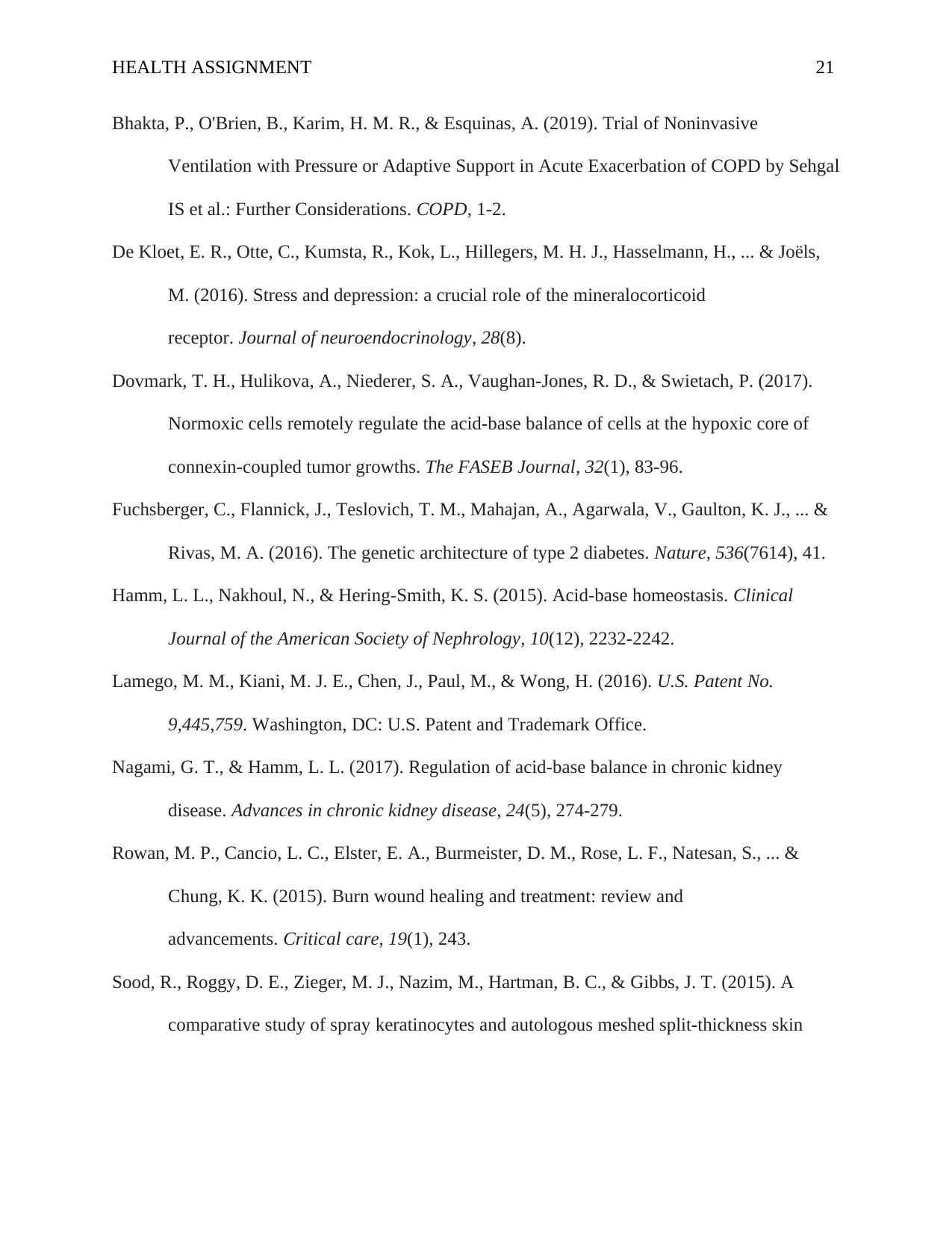
HEALTH ASSIGNMENT 21
Bhakta, P., O'Brien, B., Karim, H. M. R., & Esquinas, A. (2019). Trial of Noninvasive
Ventilation with Pressure or Adaptive Support in Acute Exacerbation of COPD by Sehgal
IS et al.: Further Considerations. COPD, 1-2.
De Kloet, E. R., Otte, C., Kumsta, R., Kok, L., Hillegers, M. H. J., Hasselmann, H., ... & Joëls,
M. (2016). Stress and depression: a crucial role of the mineralocorticoid
receptor. Journal of neuroendocrinology, 28(8).
Dovmark, T. H., Hulikova, A., Niederer, S. A., Vaughan-Jones, R. D., & Swietach, P. (2017).
Normoxic cells remotely regulate the acid-base balance of cells at the hypoxic core of
connexin-coupled tumor growths. The FASEB Journal, 32(1), 83-96.
Fuchsberger, C., Flannick, J., Teslovich, T. M., Mahajan, A., Agarwala, V., Gaulton, K. J., ... &
Rivas, M. A. (2016). The genetic architecture of type 2 diabetes. Nature, 536(7614), 41.
Hamm, L. L., Nakhoul, N., & Hering-Smith, K. S. (2015). Acid-base homeostasis. Clinical
Journal of the American Society of Nephrology, 10(12), 2232-2242.
Lamego, M. M., Kiani, M. J. E., Chen, J., Paul, M., & Wong, H. (2016). U.S. Patent No.
9,445,759. Washington, DC: U.S. Patent and Trademark Office.
Nagami, G. T., & Hamm, L. L. (2017). Regulation of acid-base balance in chronic kidney
disease. Advances in chronic kidney disease, 24(5), 274-279.
Rowan, M. P., Cancio, L. C., Elster, E. A., Burmeister, D. M., Rose, L. F., Natesan, S., ... &
Chung, K. K. (2015). Burn wound healing and treatment: review and
advancements. Critical care, 19(1), 243.
Sood, R., Roggy, D. E., Zieger, M. J., Nazim, M., Hartman, B. C., & Gibbs, J. T. (2015). A
comparative study of spray keratinocytes and autologous meshed split-thickness skin
Bhakta, P., O'Brien, B., Karim, H. M. R., & Esquinas, A. (2019). Trial of Noninvasive
Ventilation with Pressure or Adaptive Support in Acute Exacerbation of COPD by Sehgal
IS et al.: Further Considerations. COPD, 1-2.
De Kloet, E. R., Otte, C., Kumsta, R., Kok, L., Hillegers, M. H. J., Hasselmann, H., ... & Joëls,
M. (2016). Stress and depression: a crucial role of the mineralocorticoid
receptor. Journal of neuroendocrinology, 28(8).
Dovmark, T. H., Hulikova, A., Niederer, S. A., Vaughan-Jones, R. D., & Swietach, P. (2017).
Normoxic cells remotely regulate the acid-base balance of cells at the hypoxic core of
connexin-coupled tumor growths. The FASEB Journal, 32(1), 83-96.
Fuchsberger, C., Flannick, J., Teslovich, T. M., Mahajan, A., Agarwala, V., Gaulton, K. J., ... &
Rivas, M. A. (2016). The genetic architecture of type 2 diabetes. Nature, 536(7614), 41.
Hamm, L. L., Nakhoul, N., & Hering-Smith, K. S. (2015). Acid-base homeostasis. Clinical
Journal of the American Society of Nephrology, 10(12), 2232-2242.
Lamego, M. M., Kiani, M. J. E., Chen, J., Paul, M., & Wong, H. (2016). U.S. Patent No.
9,445,759. Washington, DC: U.S. Patent and Trademark Office.
Nagami, G. T., & Hamm, L. L. (2017). Regulation of acid-base balance in chronic kidney
disease. Advances in chronic kidney disease, 24(5), 274-279.
Rowan, M. P., Cancio, L. C., Elster, E. A., Burmeister, D. M., Rose, L. F., Natesan, S., ... &
Chung, K. K. (2015). Burn wound healing and treatment: review and
advancements. Critical care, 19(1), 243.
Sood, R., Roggy, D. E., Zieger, M. J., Nazim, M., Hartman, B. C., & Gibbs, J. T. (2015). A
comparative study of spray keratinocytes and autologous meshed split-thickness skin
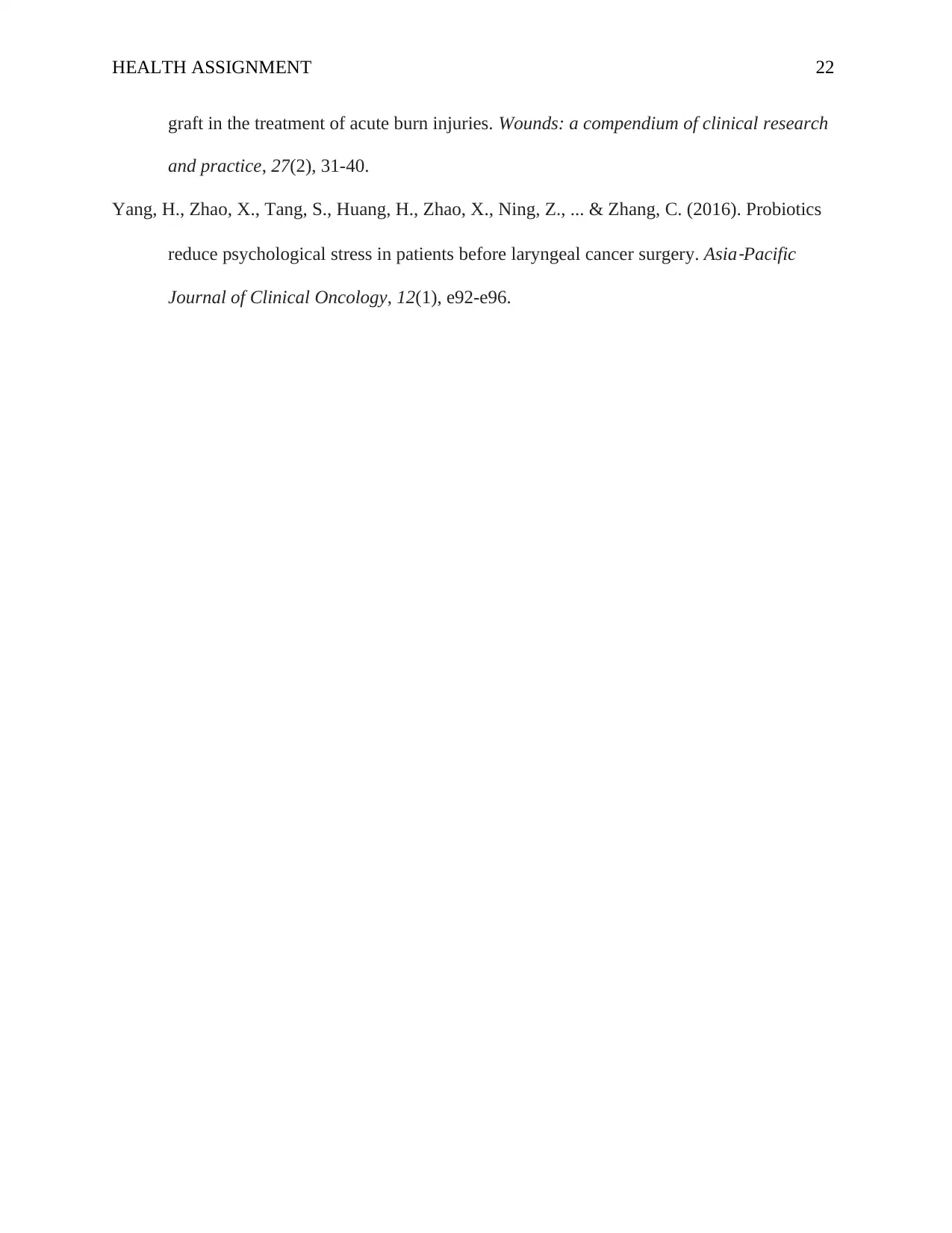
HEALTH ASSIGNMENT 22
graft in the treatment of acute burn injuries. Wounds: a compendium of clinical research
and practice, 27(2), 31-40.
Yang, H., Zhao, X., Tang, S., Huang, H., Zhao, X., Ning, Z., ... & Zhang, C. (2016). Probiotics
reduce psychological stress in patients before laryngeal cancer surgery. Asia
‐Pacific
Journal of Clinical Oncology, 12(1), e92-e96.
graft in the treatment of acute burn injuries. Wounds: a compendium of clinical research
and practice, 27(2), 31-40.
Yang, H., Zhao, X., Tang, S., Huang, H., Zhao, X., Ning, Z., ... & Zhang, C. (2016). Probiotics
reduce psychological stress in patients before laryngeal cancer surgery. Asia
‐Pacific
Journal of Clinical Oncology, 12(1), e92-e96.
1 out of 22
Related Documents
Your All-in-One AI-Powered Toolkit for Academic Success.
+13062052269
info@desklib.com
Available 24*7 on WhatsApp / Email
![[object Object]](/_next/static/media/star-bottom.7253800d.svg)
Unlock your academic potential
© 2024 | Zucol Services PVT LTD | All rights reserved.



